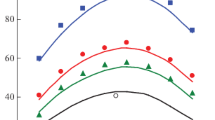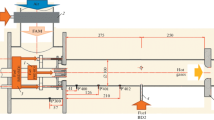Abstract
A kinetic model is developed for calculating the emission characteristics of homogeneous combustors using methane and synthesis gas (syngas) as a fuel. The model is validated over a large set of experimental data on concentrations of NO, CO, and OH in laminar flames and in the Bunsen burner and on concentrations of OH, NO, and CO in a homogeneous combustor operating on a mixture of syngas with air. At an identical temperature of combustion products, i.e., identical thermodynamic efficiency, the combustor operating on syngas is demonstrated to emit a greater amount of NO, CO, and CO2, as compared with the combustor operating on methane. Though the use of syngas allows one to organize stable combustion of ultralean mixtures and to obtain extremely low concentrations of NO and CO at the combustor exit (≈1–3 ppm), the amount of CO2 in the exhaust of even extremely lean mixtures (α ≈ 3) is appreciably greater than that in the case of using methane.
Similar content being viewed by others
References
J. Warnatz, U. Maas, amd R. W. Dibble, Combustion. Physical and Chemical Fundamentals, Modeling and Simulations, Experiments, Pollutant Formation (Springer, Berlin, 2001).
T. S. Cheng, Y.-C. Chao, D.-C. Wu, et al., “Effects of Fuel-Air Mixing on Flame Structures and NOx Emissions in Swirling Methane Jet Flames,” in 27th Symp. (Int.) on Combustion (The Combus. Inst., 1998), pp. 1229–1237.
T. S. Cheng, Y.-C. Chao, D.-C. Wu, et al., “Effects of Partial Premixing on Pollutant Emissions in Swirling Methane Jet Flames,” Combust. Flame 125, 865–878 (2001).
G. J. Rortveit, K. Zepter, O. Skreiberg, et al., “A Comparison of Low-NOx Burners for Combustion of Methane and Hydrogen Mixtures,” Proc. Combust. Inst. 29, 1123–1129 (2002).
R. W. Schefer, D. M. Wicksall, and A. K. Agrawal, “Combustion of Hydrogen-Enriched Methane in a Lean Premixed Swirl-Stabilized Burner,” Proc. Combust. Inst. 29, 843–851 (2002).
J.-Y. Ren, F. N. Egolfopoulos, and T. T. Tsotsis, “NOx Emission Control of Lean Methane-Air Combustion with Addition of Methane Reforming Products,” Combust. Sci. Technol. 174(4), 181–205 (2002).
D. Zhao, H. Yamashita, K. Kitagawa, N. Arai, and T. Furuhata, “Behavior and Effect on NOx Formation of OH Radical in Methane-Air Diffusion Flame with Steam Addition,” Combust. Flame 130, 352–360 (2002).
A. F. Ghoniem, A. Annaswamy, S. Park, and Z. C. Sobhani, “Stability and Emissions Control Using Air Injection and H2 Addition in Premixed Combustion,” Proc. Combust. Inst. 30, 1765–1773 (2005).
H. Guo, G. J. Smallwood, F. Liu, Y. Ju, and O. L. Gulder, “The Effect of Hydrogen Addition on Flammability Limit and NOx Emission in Ultra-Lean Counterflow CH4/Air Premixed Flames,” Proc. Combust. Inst. 30, 303–311 (2005).
N. Aida, T. Nishijima, S. Hayashi, H. Yamada, and T. Kawakami, “Combustion of Lean Prevaporized Fuel-Air Mixtures Mixed with Hot Burned Gas for Low-NOx Emissions over an Extended Range of Fuel-Air Ratios,” Proc. Combust. Inst. 30, 2885–2892 (2005).
L. P. Rangel, L. M. Fletcher, M. Pourkashanian, and A. Williams, “Fundamental Studies of a Partial Premixed Counter-Flow Combustion System and its Effect on NOx Emissions,” Combust. Sci. Technol. 178(8), 1457–1476 (2006).
M. J. Landman, M. A. F. Derksen, and J. B. W. Kok, “Effect of Combustion Air Dilution by Water Vapor or Nitrogen on NOx Emission in a Premixed Turbulent Natural Gas Flame: An Experimental Study,” Combust. Sci. Technol. 178(4), 623–634 (2006).
A. M. Briones, S. Som, and S. Aggarwal, “Effect of Multistage Combustion on NOx Emissions in Methane-Air Flames,” Combust. Flame 149, 448–462 (2007).
H. Xue and S. K. Aggarwal, “NOx Emissions in n-Heptane/Air Partially Premixed Flames,” Combust. Flame 132, 723–741 (2003).
L. K. Sze, C. S. Cheung, and C. W. Leung, “Appearance, Temperature, and NOx Emission of Two Increase Diffusion Flames with Different Port Design,” Combust. Flame 144, 237–248 (2006).
S. Naha and S. K. Aggarwal, “Fuel Effects on NOx Emissions in Partially Premixed Flames,” Combust. Flame 139, 90–105 (2004).
M. S. Day, J. B. Bell, X. Gao, and P. Glarborg, “Numerical Simulation of Nitrogen Oxide Formation in Lean Premixed Turbulent H2/O2/N2 Flames,” Proc. Combust. Inst., 33, 1591–1599 (2011).
H. Watanabe, J. Yamamoto, and K. Okazaki, “NOx Formation and Reduction Mechanisms in Staged O2/CO2 Combustion,” Combust. Flame 158, 1255–1263 (2011).
F. Biagioli and F. Güthe, “Effect of Pressure and Fuel-Air Unmixedness on NOx Emissions from Industrial Gas Turbine Burners,” Combust. Flame 151, 274–288 (2007).
P. Griebel, R. Bombach, A. Inauen, et al., “Flame Characteristics and Turbulent Flame Speeds of Turbulent, High-Pressure, Lean Premixed Methane/Air Flames,” in Proc. of ASME Turbo Expo 2005: Power for Land, Sea, and Air (Reno-Tahoe, Nevada, USA, GT2005-68565, 2005).
S. K. Vedeshkin and E. D. Sverdlov, “Organization of Low-Emission Burning of Gas in Gas-Turbine Plants,” Teploenergetika, No. 11, 10 (2005) [Thermal Eng. 52 (11), 838–848 (2005)].
A. Frassoldati, A. Cuaci, T. Faravelli, et al., “Experimental and Modeling Study of a Low NOx Combustor for Aero-Engine Turbofan,” Combust. Sci. Technol. 181(3), 483–495 (2009).
S. Daniele, P. Jansohn, and K. Boulouchos, “Flashback Propensity of Syngas Flames at High Pressure: Diagnostic and Control,” in Proc. of ASME Turbo Expo 2010: Power for Land, Sea and Air, June 14–18, 2010, Glasgow, UK, GT2010-23456.
D. J. Wilhelm, D. R. Simbeck, A. D. Karp, and R. L. Dickenson, “Syngas Production for Gas-to-Liquids Applications: Technologies, Issues and Outlook,” Fuel Proces. Technol. 71, 139–148 (2001).
M. Chaos and F. L. Dryer, “Syngas Combustion Kinetics and Applications,” Combust. Sci. Technol. 180(6), 1053–1096 (2008).
M. Deminsky, V. Jivotov, B. Potapkin, and V. Rusanov, “Plasma-Assisted Production of Hydrogen from Hydrocarbons,” Pure Appl. Chem. 74(3), 413–418 (2002).
A. E. Lutz, R.W. Bradshaw, L. Bromberg, and A. Rabinovich, “Thermodynamic Analysis of Hydrogen Production by Partial Oxidation Reforming,” Int. J. Hydrogen Energy 29(8), 809–816 (2004).
A. Fridman and L. Kennedy, Plasma Physics and Engineering (Taylor and Francis, New York, 2004).
J. A. Miller and C. T. Bowman, “Mechanism and Modeling of Nitrogen Chemistry in Combustion,” Prog. Energy Combust. Sci. 15(4), 287–338 (1989).
GRI-Mech 3.0 G. P. Smith, D. M. Golden, M. Frenklach, et al., GRI-Mech 3.0 (1999); www.me.berkeley.edu/grimech/version30/text30.html.
N. G. Dautov and A. M. Starik, “On the Problem of Choosing a Kinetic Scheme for the Homogeneous Reaction of Methane with Air,” Kinet. Katal. 38(2), 207–230 (1997) [Kinet. Catal. 38 (2), 185–208 (1997)].
A. A. Konnov, “Detailed Reaction Mechanism for Small Hydrocarbons Combustion. Release 0.5,” http://homepages.vub.ac.be/~akonnov/ (2000).
A. B. Lebedev, A. N. Secundov, A. M. Starik, et al., “Modeling Study of Gas-Turbine Combustor Emission,” Proc. Combust. Inst., 32(2), 2941–2947 (2009).
V. E. Kozlov, A. B. Lebedev, A. N. Sekundov, et al., “Application of Reactor Models for Calculating Emission Characteristics of Diffusion and Homogeneous Combustors,” in Environmental Problems of Aviation, Ed. by Yu. D. Khaletskii (Torus Press, Moscow, 2010), pp. 321–338 [in Russian].
C. P. Fenimore, “Formation of Nitric Oxide in Premixed Hydrocarbon Flames,” in 13th Symp. (Int.) on Combustion (The Combustion Inst., 1971), pp. 373–379.
P. C. Matle and D. T. Pratt, “Measurement of Atomic Oxygen and Nitrogen Oxides in Jet-Stirred Combustion,” in 15th Symp. (Int.) on Combustion (The Combustion Inst., 1975), pp. 1061–1070.
A. M. Starik, V. E. Kozlov, and N. S. Titova, “On the Influence of Singlet Oxygen Molecules on the Speed of Flame Propagation in Methane-Air Mixture,” Combust. Flame 157(2), 313–327 (2010).
A. M. Starik, N. S. Titova, A. S. Sharipov, and V. E. Kozlov, “Syngas Oxidation Mechanism,” Fiz. Goreniya Vzryva 46(5), 3–19 (2010) [Combust., Expl., Shock Waves 46 (5), 491–506 (2010)].
P. S. Kuleshov, A. M. Starik, and N. S. Titova, “Kinetics of Oxidation and Combustion of Methane and Propane,” in Nonequilibrium Physicochemical Processes in Gas Flows and Novel Concepts of Combustion, Ed. by A. M. Starik (Torus Press, Moscow, 2011), pp. 53–87 [in Russian].
A. Fernandez, A. Goumri, and A. Fontijn, “Kinetics of the Reactions of N(4S) Atoms with O2 and CO2 over Wide Temperatures Ranges,” J. Phys. Chem. A 102(1), 168–172 (1998).
W. Hack, K. Hoyermann, and H. G. Wagner, “The Reaction of NO + HO2 →NO2 + OH with OH + H2O2 →HO2 + H2O as an HO2-Source,” Int. J. Chem. Kinet. 7, 329 (1975).
W. Tsang and J. T. Herron, “Chemical Kinetic Data Base for Propellant Combustion. I. Reactions Involving NO, NO2, HNO, HNO2, HCN and N2 O,” J. Phys. Chem. Ref. Data 20(4), 609–663 (1991).
I. V. Zaslonko, A. M. Tereza, O. N. Kulish, and D. Yu. Zheldakov, “Kinetic Aspects of Reduction of the Nitrogen Oxide Level in Combustion Products by Addition of Ammonia (De-NOx), Khim. Fiz. 11(11), 1491–1517 (1992).
M. V. Bochkov, L. A. Lovachev, and B. N. Chetverushkin, “Chemical Kinetics of NOx Formation during Methane Combustion in Air,” Mat. Model. 4(9), 3–36 (1992).
M. V. Kantak, K. S. de Manrique, R. H. Aglave, and R. P. Hesketh, “Methylamine Oxidation in a Flow Reactor: Mechanism and Modeling,” Combust. Flame 108, 235–265 (1997).
G. Weibring and R. Zellner, “Chemistry in Plumes of High-Flying Aircraft with H2 Combustion Engines: A Modeling Study,” Ann. Geophys. 12(5), 403–408 (1994).
M.W. Slack and A. R. Grillo, “Shock Tube Investigation of Methane-Oxygen Ignition Sensitized by NO2,” Combust. Flame 40, 155–172 (1981).
L. V. Gurvich, I. V. Veits, V. A. Medvedev, et al., Thermodynamic Properties of Individual Substances: Reference Book, Ed. by V. P. Glushko (Nauka, Moscow, 1978).
E. Goos, A. Burcat, and B. Ruscic, “Ideal Gas Thermochemical Database with Updates from Active Thermochemical Tables,” ftp://ftp.technion.ac.il/pub/supported/aetdd/thermodynamics; www.garfield.chem.elte.hu/Burcat/burcat.html;date.
A. A. Konnov, I. V. Dyakov, and J. de Ruyck, “Probe Sampling Measurements and Modeling Nitric Oxide Formation in Methane-Air Flames,” Combust. Sci. Technol. 169(1), 127–153 (2001).
Q. V. Nguyen, R. W. Dibble, C. D. Carter, et al., “Raman-LIF Measurements of Temperature, Major Species, OH and NO in a Methane-Air Bunzen Flame,” Combust. Flame 105, 499–510 (1996).
A. Van Maaren and L. P. H. de Goey, “Laser Doppler Thermometry in Flat Flames,” Combust. Sci. Technol. 99(1), 105–118 (1994).
R. J. Kee, F. M. Rupley, J. A. Miller, et al., CHEMKIN, Release 4.0 (Reaction Design, San Diego, 2004).
ANSYS FLUENT User’s Guide, Version 12 (ANSYS Inc., January 2009).
C. T. Bowman et al., “GRI-Mech 2.11,” http://www.me.berkeley.edu/~grimech/new21/version21/text21.html.
E. Giacomazzi, D. Cecerel, F. Donato, et al., “LES Analysis of a Syngas Turbulent Premixed Dump-Combustor at 5 Bar,” in Int. Conf. on Processes and Technologies for a Sustainable Energy, Ischia, June 27–30, 2010.
B. E. Launder and D. B. Spalding, Lectures in Mathematical Models of Turbulence (Academic Press, London, 1972).
B. F. Magnussen, “On the Structure of Turbulence and a Generalized Eddy Dissipation Concept for Chemical Reaction in Turbulent Flow,” in 19th AIAA Meeting (St. Louis, 1981).
I. R. Gran and B. F. Magnussen, “A Numerical Study of a Bluff-Body Stabilized Diffusion Flame. Part 2. Influence of Combustion Modeling and Finite-Rate Chemistry,” Combust. Sci. Technol. 119(1), 191–217 (1996).
A. Habibi, B. Merci, and G. J. Heynderickx, “Multiscale Modeling of Turbulent Combustion and NOx Emission in Steam Crackers,” AIChE J. 53(9), 2384–2398 (2007).
A. De Pascale, M. Fussi, and A. Peretto, “Numerical Simulation of Biomass Derived Syngas Combustion in a Swirl Flame Combustor,” in Proc. of ASME Turbo Expo 2010: Power for Land, Sea and Air, June 14–18, 2010, Glasgow, UK, GT2010-22791.
Q. V. Nguyen, B. L. Edgar, R. W. Dibble, and A. Gulati, “Experimental and Numerical Comparison of Extractive and In Situ Laser Measurements of Non-Equilibrium Carbon Monoxide in Lean-Premixed Natural Gas Combustion,” Combust. Flame 100, 395–406 (1995).
Author information
Authors and Affiliations
Corresponding author
Additional information
Original Russian Text © V.E. Kozlov, A.M. Starik, N.S. Titova, I.Yu. Vedishchev.
__________
Translated from Fizika Goreniya i Vzryva, Vol. 49, No. 5, pp. 17–33, September–October, 2013.
Rights and permissions
About this article
Cite this article
Kozlov, V.E., Starik, A.M., Titova, N.S. et al. On mechanisms of formation of environmentally harmful compounds in homogeneous combustors. Combust Explos Shock Waves 49, 520–535 (2013). https://doi.org/10.1134/S0010508213050031
Received:
Revised:
Published:
Issue Date:
DOI: https://doi.org/10.1134/S0010508213050031




